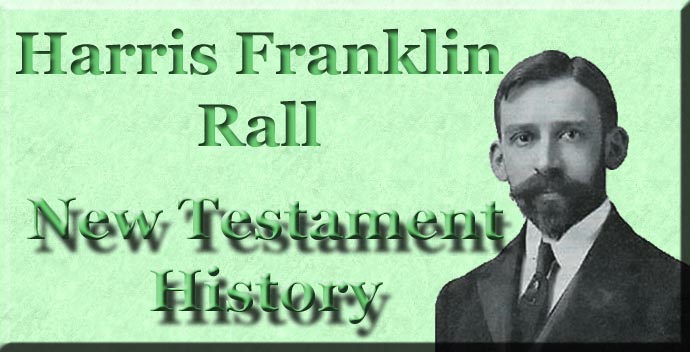
New Testament History
By Harris Franklin Rall
Introduction
|
This history might be more strictly called a study of the beginnings of Christianity. While designed primarily for use as a college textbook, it should be of equal value to any reader who wishes to trace the story of Christianity in its first days. This is first of all a historical study. The average man has been wont to regard Christianity as a fixed and finished something that has been dropped down from the skies. If you speak of the Christian religion he will think first of all of a collection of writings, or of a body of doctrine, or of the institution of the church. But these three, Bible and doctrine and church, are simply the products of a greater movement that lies back of them. To understand Christianity we must go back to this great current of life, which was at once the greatest revelation of the divine Spirit and the greatest movement of the human spirit that mankind has known. What was the world to which this new life came? What did its Founder teach and do? How did the world brotherhood come out of the little company of Jews that followed him? This book is a study of religion. That is why this history is of such supreme interest to us. It brings to us the religion that dominates the faith and conscience of men today, and shows us this religion in the person of its great founders and in the transforming power of its first great enthusiasm. It is a misconception of what New Testament study should be, to burden it with the elaborate discussion of dates and customs and the like. The supreme interest of the New Testament writers is in religion. What they bring us is not so much a history of this religion or a statement of its doctrines. Their pages reflect, rather, the religion itself, the rich and varied life out of which all doctrine and institutions grew. The study of this life is the best possible introduction to the understanding of religion. The final aim of this volume is to secure the study of the Bible itself. To this end directions for reading and study are placed at the end of each chapter. The Scripture passages here given should be read carefully in connection with the text, after which the other directions for study should be carried out. The instructor will naturally modify these directions to suit the needs of the individual class. The text aims to set the biblical materials in their historical relations and to interpret them as part of a great movement. The instructor, however, should not be content with question and answer based upon the text, but should aim to secure first of all an interested and intelligent reading of the Bible itself. While written frankly from the modern historical point of view, this book does not concern itself primarily with critical processes. Using the assured results of sober study, it aims to set forth reverently and constructively the great facts of this early history. It is a pleasure to acknowledge the aid received, especially in the revision of the manuscript, from my colleague, Professor Lindsay B. Longacre. A brief bibliography is appended. The body of the work contains no references to other authors. The Bible itself is the only book needed. The student should have a copy of the American Revised Version with marginal references. Harris Franklin Rall. |
|
 |
 |
|
|
|
-
Site Navigation
 Home
Home What's New
What's New Bible
Bible Photos
Photos Hiking
Hiking E-Books
E-Books Genealogy
Genealogy Profile
Free Plug-ins You May Need
Profile
Free Plug-ins You May Need
 Get Java
Get Java.png) Get Flash
Get Flash Get 7-Zip
Get 7-Zip Get Acrobat Reader
Get Acrobat Reader Get TheWORD
Get TheWORD